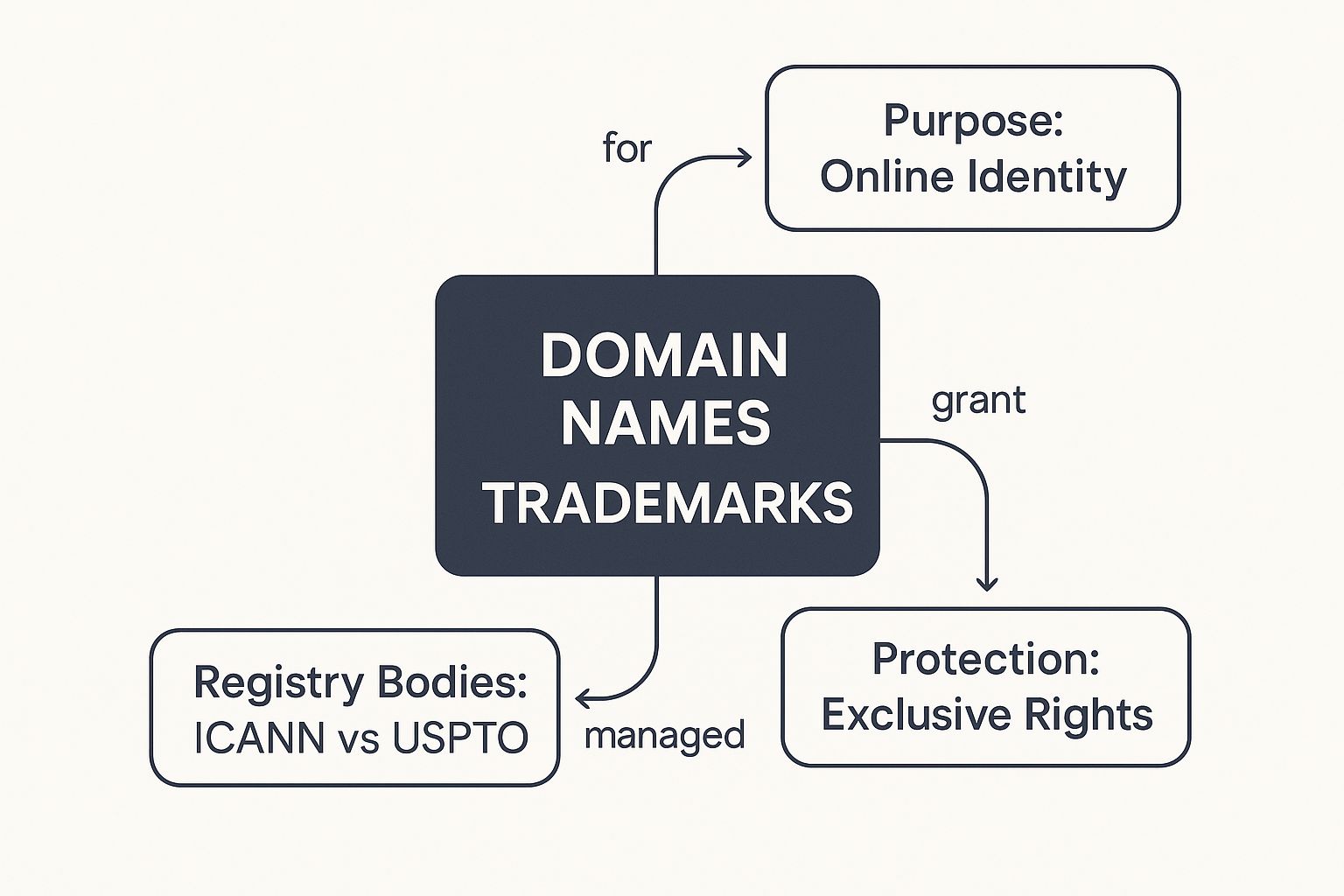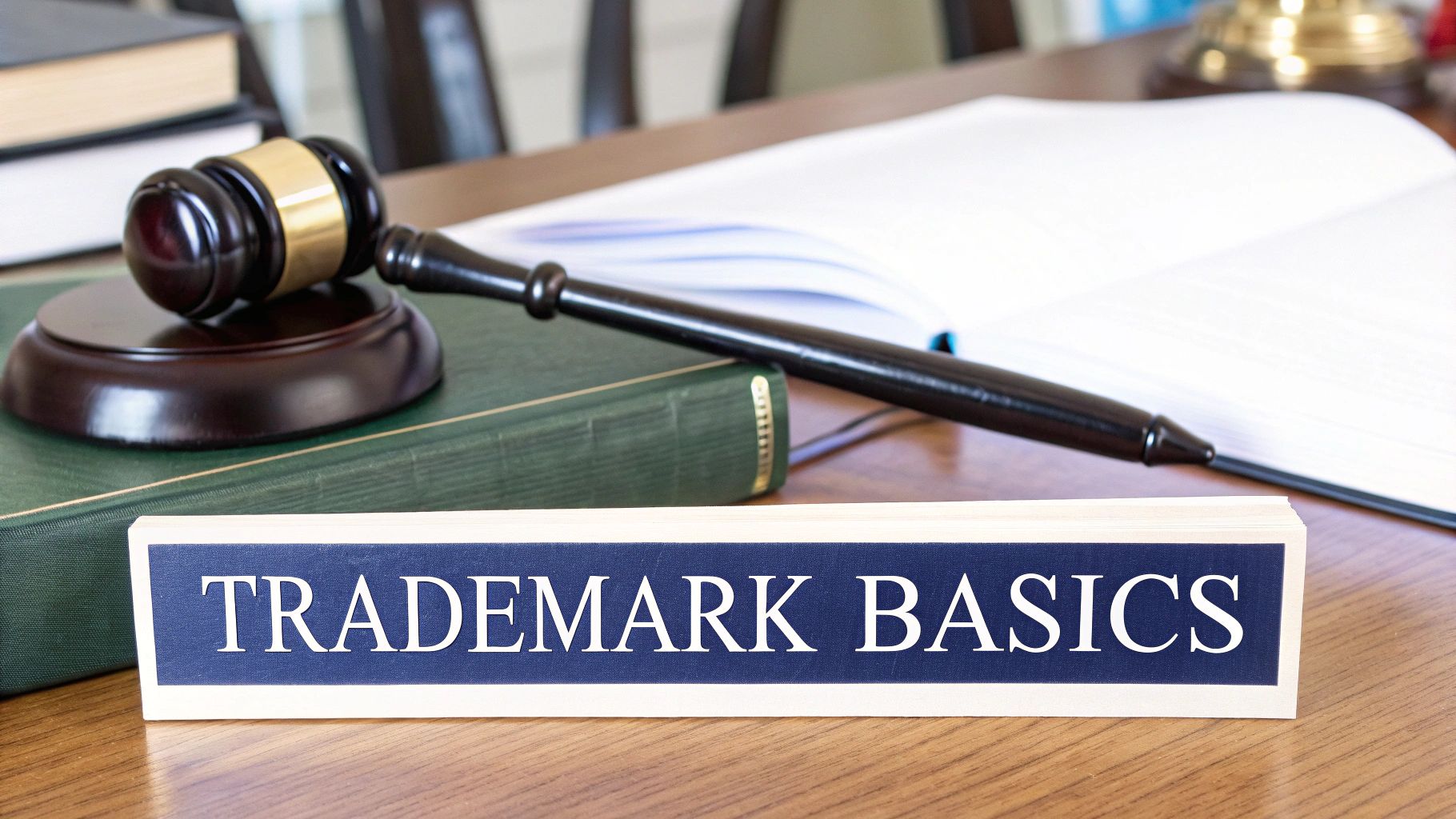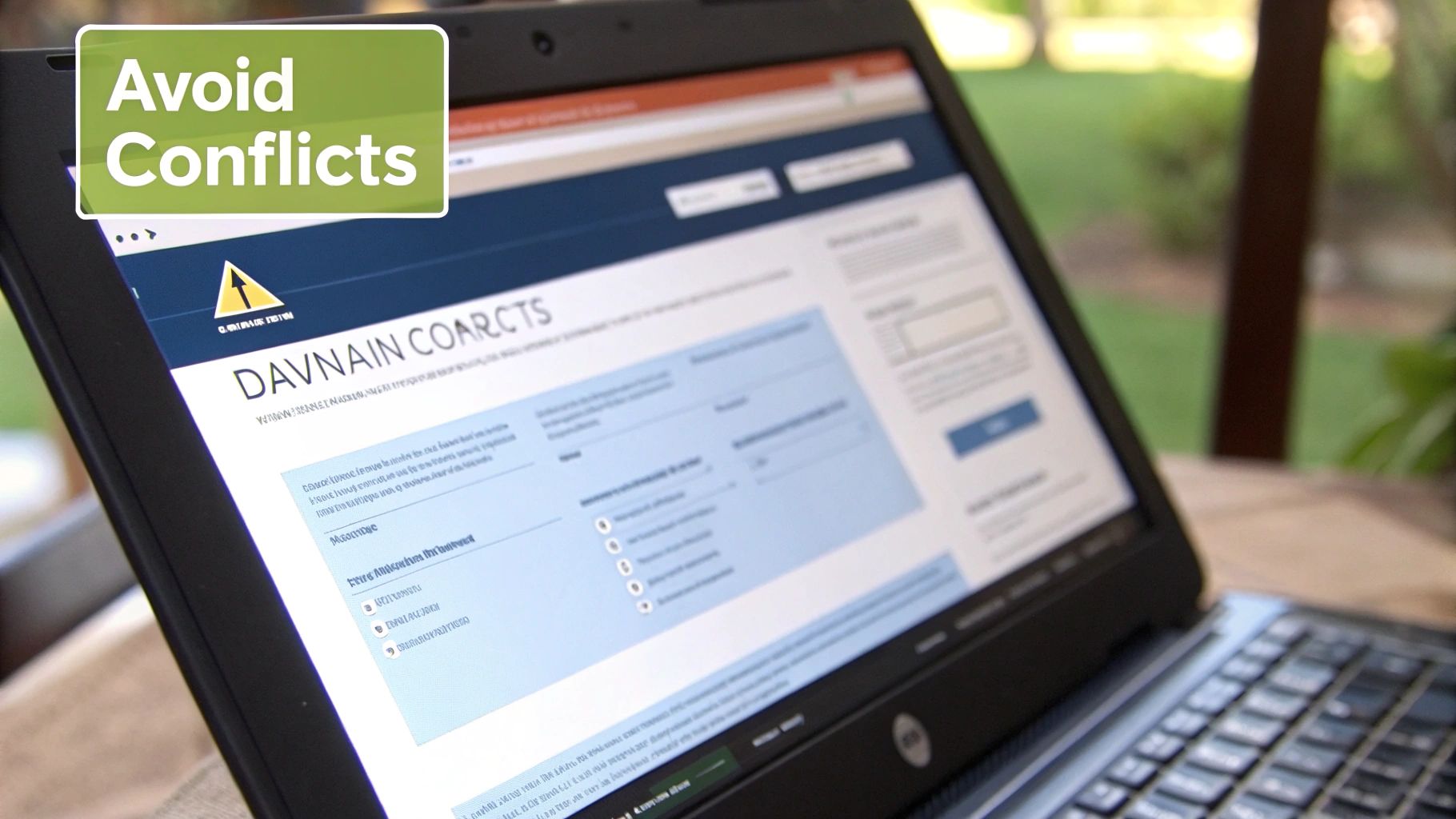It's a classic mix-up for new entrepreneurs: thinking a domain name and a trademark are the same thing. They're not. In fact, they serve two completely different purposes, and understanding that difference is critical.
A domain name is simply your address on the internet, like yourbrand.com. It’s how people find your digital doorstep. A trademark, on the other hand, is your legal brand identity—the name, logo, or slogan that tells the world your products or services are yours and not someone else's.
Your Digital Address vs. Your Brand Identity
Let's use an analogy. Imagine your business is a brick-and-mortar shop.
Your domain name is the street address plaque hanging next to the front door. It’s a unique identifier that tells people exactly where to find your store in the massive city that is the internet. Without it, your customers would be lost.
A trademark, however, is the big, flashy neon sign above that door—the one with your unique name and logo. It’s what people recognize from down the block. It’s your reputation, a signal of quality, and what tells customers, “Hey, this is the brand you know and trust,” separating you from every other generic shop on the street.
While you absolutely want your address and your sign to match, they are fundamentally different things with their own sets of rules and legal protections. Just because you own the address doesn't automatically mean you own the sign.
To get a clearer picture, let's put these two concepts side-by-side.
Domain Name vs Trademark Quick Comparison
| Attribute | Domain Name | Trademark |
|---|---|---|
| Primary Purpose | To serve as a unique, memorable online address for a website. | To identify the source of goods or services and distinguish them from competitors. |
| Function | Technical. It points users to a specific server on the internet. | Commercial and Legal. It protects brand identity and consumer goodwill. |
| Governing Body | ICANN (Internet Corporation for Assigned Names and Numbers) via registrars. | National or regional government offices (like the USPTO in the U.S.). |
| Scope of Protection | Global and exclusive for that specific address (.com, .org, etc.). | Limited to specific goods/services and geographic regions where registered. |
| Uniqueness Rule | Only one person or entity can own yourbrand.com at a time. | Multiple entities can own similar names if they operate in different industries. |
This table neatly sums up the core differences, but the real-world implications are where it gets interesting.
Understanding Their Roles and Protections
This distinction is so important because each asset is governed by a different authority and grants you different rights. Owning a domain gives you the exclusive right to use that specific web address. That’s it. It does not stop someone from using a similar name for their brand offline, on social media, or even registering it as a trademark.
A trademark gives you the exclusive right to use your brand name in connection with specific goods or services, preventing others from causing consumer confusion in the marketplace, regardless of the domain they use.
This separation of purpose, protection, and governing bodies is the key takeaway. The infographic below helps visualize how these two concepts relate yet remain distinct.

As the graphic shows, a domain's job is to provide an online location, managed by ICANN. A trademark's job is to protect your exclusive brand rights, overseen by government offices like the USPTO.
This system has fueled a massive market for digital real estate. Globally, there were 371.7 million domain name registrations as of the second quarter of this year, a 2.6% increase from the previous year. If you want to dive deeper, you can check out the full .
How to Secure Your Domain Name

Claiming your digital address is one of the most exciting first steps for any new venture. It’s the moment your idea starts to feel real. But securing the right domain name involves more than just finding a catchy phrase; it’s a strategic move that needs to align with your brand and shield you from future headaches. The whole process kicks off with some good old-fashioned brainstorming.
Think about a name that’s easy to remember, spell, and say out loud. Try to steer clear of hyphens and numbers if you can—they can be clumsy for people to type and sound awkward when you tell someone your website. Your domain name is a core piece of your brand, so it has to reflect what your business is all about.
Choosing Your Registrar and Extension
Once you have a few solid ideas, your next stop is a domain registrar. These are the companies accredited by ICANN (Internet Corporation for Assigned Names and Numbers) to manage domain name reservations. Think of them as the official land registry for the internet. Look for registrars with clear, upfront pricing, helpful customer support, and a trustworthy reputation.
Next up, you'll need to pick a Top-Level Domain (TLD). That's the extension at the end of your name, like .com, .org, or .net. While .com is still the undisputed king, there are tons of newer options that might be a better fit.
- .com: The gold standard. It's universally recognized and often the first choice for businesses.
- .org: Traditionally used by non-profits and organizations.
- .co: A popular, shorter alternative to
.com, often picked up by startups. - .io: Very common in the tech and software-as-a-service (SaaS) worlds.
- .shop or .store: Perfect for e-commerce sites, as they immediately tell visitors what you do.
The right TLD can set customer expectations before they even land on your site. A .io domain might signal a tech focus, while a .shop clearly points to retail.
Crucial First Step: Before you hit that "buy" button, you absolutely must check if your desired name—or something very similar—is already a registered trademark. A quick search on the can save you from a world of legal and financial pain down the road. Owning
coolgadgets.comwon’t protect you one bit if another company already owns the trademark for "Cool Gadgets."
What to Do If Your First Choice Is Taken
It’s a classic problem: your perfect domain name is already registered. Don't panic. You have options. First, try some simple variations. Could you add a verb, like getcoolgadgets.com? Or maybe get specific with your location, like coolgadgetsnyc.com?
If you're really set on the original, you can check if the domain is listed for sale on a marketplace. You could also use a WHOIS lookup tool to find the owner's contact info and try making an offer directly. Just be ready to negotiate—premium domains are valuable assets, and their owners know it.
Securing your domain is a foundational step in building your online presence. By carefully thinking through your name, choosing the right TLD, and doing your homework on existing domain names and trademarks, you set your brand up for success right from the start.
How to Register Your Trademark

If grabbing a domain name is like claiming your spot on the internet, registering a trademark is like getting a government-issued deed to your brand itself. It takes your name or logo from being just a business card placeholder to a legally protected asset, giving you exclusive rights to use it in your field. The process might sound a bit heavy, but it's actually pretty straightforward once you break it down.
The absolute first thing you have to do is a thorough trademark search. You need to be sure your brand name isn't already taken or confusingly close to one that is. A quick Google search won't cut it here; you have to dig into the official database, like the United States Patent and Trademark Office's (USPTO) TESS database. Trust me, skipping this step can lead to a rejected application or, even worse, a costly legal mess down the road.
Preparing Your Application
Once you're confident your mark is unique, it's time to get your application ready. This means making a few key choices. First up, you have to decide what kind of mark you’re actually registering.
- Standard Character Mark: This protects the name itself, no matter the font, style, or color. It gives you the broadest protection for your brand name (think the word "Nike").
- Special Form Mark (Stylized/Logo): This protects a specific design, including any unique fonts, colors, and graphic elements (like the Nike "swoosh" logo).
You also have to get specific about the goods or services your trademark will cover. Trademark rights are tied to how you use them in business, so you'll need to pick the right "classes" from a list. This makes sure your legal protection actually lines up with what your business does.
Filing the Right Way
Next, you'll choose your filing basis. This really just depends on whether you're already using your trademark out in the wild.
An in-use application is for brands that are already selling products or services with that mark. You’ll need to prove it with what’s called a "specimen"—something that shows the mark as your customers would see it, like a photo of your product packaging or a screenshot from your website's checkout page.
On the other hand, an intent-to-use (ITU) application lets you reserve a mark you plan on using soon. It’s a smart way to lock down your rights early, but you will have to prove you’re actually using it before the registration becomes final.
After you file, an examining attorney at the USPTO will review everything to make sure it's legally sound. If they spot any issues, they’ll send you an "Office Action" letter that you'll have to respond to. Once you get the all-clear, your mark is published for anyone to oppose. If no one objects, congratulations—your trademark will be officially registered.
This registration is a massive win. It gives you nationwide protection and the legal power to stop others from infringing on your brand. It also opens up new ways to make money, like licensing a trademark to other companies in exchange for royalties. By taking the time to handle the registration process correctly, you're building a rock-solid foundation for your brand's future.
When Domains and Trademarks Collide
The moment your brand starts getting recognized is exciting, but it's also when the waters between domain names and trademarks can get choppy. This is where conflicts often arise, turning what should be a simple web address into a potential legal battleground. The most common and frustrating issue? Cybersquatting.
Imagine you’ve built a beloved coffee shop, "Astro Coffee," but you haven't gotten around to registering the domain astrocoffee.com yet. A cybersquatter, noticing your growing success, snatches up the domain. Their goal is simple: hold it hostage and try to sell it back to you for an outrageous price. They’re banking on profiting from your hard work and reputation.
This isn’t just a what-if scenario. It happens every single day to businesses of all sizes, and it can lead to serious customer confusion and lost web traffic.
Understanding Deceptive Practices
Cybersquatting is just one piece of the puzzle. Scammers use a few different sneaky tactics to prey on established brands and trick their customers. One of the most popular is typosquatting.
This is where someone registers domains that are common misspellings of your actual brand name—think astrocoffe.com or astrocofee.com. An unsuspecting customer types in the wrong URL and suddenly lands on a competitor's site, a phishing page designed to steal their information, or a page just loaded with ads. These kinds of deceptive moves can do real damage to the trust you've built with your audience.
Your Legal Path to Reclaiming Your Brand
So, what do you do when someone is squatting on your brand’s domain? You don't have to just pay the ransom. You have powerful legal options, and one of the most effective is the Uniform Domain-Name Dispute-Resolution Policy (UDRP).
The UDRP is a streamlined, cost-effective process designed specifically to resolve these kinds of disputes. It's often much faster and cheaper than filing a full-blown lawsuit in federal court.
To win a UDRP case, you generally need to prove three key things:
- Confusingly Similar: The domain name is identical or confusingly similar to a trademark that you have rights to.
- No Legitimate Interest: The person holding the domain has no real rights or legitimate reasons to own that name.
- Bad Faith: The domain was registered and is being used in bad faith (like trying to sell it back to you for a profit).
This process has a very high success rate for legitimate trademark owners. In one famous case, the Swedish telecom giant Ericsson successfully took on a Russian company that tried to register and use its trademark in a domain. The court saw it for what it was—an act of bad faith. This really drives home how vital a trademark registration is for defending your digital turf. For a deeper look at these conflicts, you can explore more about how trademark and domain names intersect in legal disputes.
Successfully navigating these challenges is a must for protecting your brand's integrity online. By understanding the threats and knowing your legal options like the UDRP, you can fight back against cybersquatters and keep your brand’s digital identity safe and sound.
Proactive Strategies to Protect Your Online Brand
When it comes to protecting your brand, waiting for a problem to appear is a losing game. A reactive approach is almost always more expensive and stressful than it needs to be.
The best defense is a good offense. Building a strong, proactive defense around your digital identity before threats like cybersquatting even have a chance to take root is the smartest move you can make. This means thinking beyond just your main .com address.
A smart first step is to register key variations of your domain name. Put yourself in the shoes of a cybersquatter for a moment. What domains would they snatch up to intercept your customers or tarnish your brand?
- Common Misspelllings: If your brand is "Astro Coffee," it’s a good idea to register
astrocoffe.comandastrocofee.com. - Different Top-Level Domains (TLDs): Secure your name across the most popular extensions. If you own the
.com, it's wise to also grab the.net,.co, or.orgto prevent someone else from setting up shop there.
This defensive registration strategy creates a protective bubble around your brand, making it much harder for bad actors to profit from your hard work. It’s a small investment that offers major peace of mind.
Monitor Your Brand Across the Web
You can't be everywhere at once, which is why domain monitoring services are so valuable. Think of these tools as your digital watchdogs, automatically scanning new domain registrations around the clock. If someone registers a domain that's confusingly similar to your trademark, you get an alert.
This early warning system allows you to act fast. You can assess whether the new domain poses a real threat and decide on the best course of action, whether that's sending a cease and desist letter or initiating a UDRP proceeding. Staying informed is half the battle, and our guide on how to avoid trademark infringement can give you the foundational knowledge you need to protect your intellectual property.
The Ever-Expanding World of TLDs
The internet's address book is getting bigger every single day. We're seeing a massive expansion of new generic Top-Level Domains (ngTLDs), like .shop, .app, .art, and hundreds more. This creates exciting new branding opportunities, letting you get a domain that perfectly describes what you do, like astroroasters.coffee.
But this growth also creates new headaches for brand protection. The image below shows just a fraction of the new TLDs that have been delegated by ICANN, illustrating just how vast this new digital territory has become.

This explosion in domain extensions means there are more places than ever for cybersquatters to hide. Your monitoring strategy now has to cover a much wider field than just the classic .com and .net.
This isn't just a small trend; it's a fundamental shift. Registrations for these new generic top-level domains (ngTLDs) recently hit about 37.8 million, a 13.5% increase year-over-year. This surge proves that the market is changing, demanding that trademark holders become more vigilant.
This new reality makes one thing clear for brand owners: Proactively securing variations of your domain names and trademarks and actively monitoring the web are no longer optional. They are essential parts of any modern brand protection strategy.
Frequently Asked Questions
Trying to figure out the overlap between domain names and trademarks can feel like untangling a knot. It’s tricky, but breaking down the common questions entrepreneurs and creatives run into is the best way to get a handle on it and build a solid brand protection strategy.
Can I Get a Trademark for My Domain Name?
Yes, you absolutely can, but there's a huge catch. You can't just trademark any old web address. Your domain name has to work as a real brand identifier—something that tells customers, "This product or service comes from this specific company."
Think about Amazon.com. That name is a powerhouse of a trademark because we all instantly connect it with one specific retail giant. It's built up what lawyers call "distinctiveness." On the flip side, a domain like cheap-laptops.com would never make the cut. It’s too generic; it just describes what's being sold instead of pointing to a unique source.
To successfully turn your domain into a registered trademark, you have to prove that when people see it, they think of you and your business, and no one else.
What Should I Do If Someone Is Using My Trademark in Their Domain?
It’s a gut-wrenching feeling to find someone else using your hard-earned trademark in their domain name. But don't panic—you have real legal options. The first move is usually to have an attorney fire off a formal cease and desist letter. More often than not, this is enough to get them to stop without a bigger fight.
If they ignore it, your best weapon is often the Uniform Domain-Name Dispute-Resolution Policy (UDRP). This process is almost always faster and cheaper than dragging someone to court. To win a UDRP case, you have to prove three specific things:
- The sketchy domain is identical or "confusingly similar" to your trademark.
- The person who registered it has no legitimate rights or reasons to own that name.
- They registered the domain and are using it in "bad faith" (meaning, they knew what they were doing).
This process is incredibly effective for business owners fighting off cybersquatters.
A registered trademark is your biggest asset in these fights. Without one, proving you have any rights at all becomes a massive uphill battle. This is why getting your trademark registered early is so vital for protecting your brand from people acting in bad faith.
Does Owning the .Com Domain Protect Me from Someone Using the .Net?
Nope. Not at all. Owning the .com for your brand gives you exactly zero legal protection if someone else swoops in and registers the .net, .org, or any other version. This is a huge misconception that leaves a ton of brands wide open to problems.
Each domain registration is a completely separate transaction. This is precisely why a smart defensive move is to buy up your brand name across several of the most popular extensions (Top-Level Domains, or TLDs).
Sure, your trademark can help you fight an infringing domain later, but honestly, just owning the most obvious variations yourself is simpler, cheaper, and way more effective. It stops brand confusion before it even starts and keeps your customers from being tricked.
Protecting your digital brand requires thinking ahead and getting the right legal advice. The team at Cordero Law helps entrepreneurs and creatives lock down their brands with smart strategies for domain names, trademarks, and all things intellectual property. If you're ready to build a strong legal foundation for your brand, get in touch with us today.
